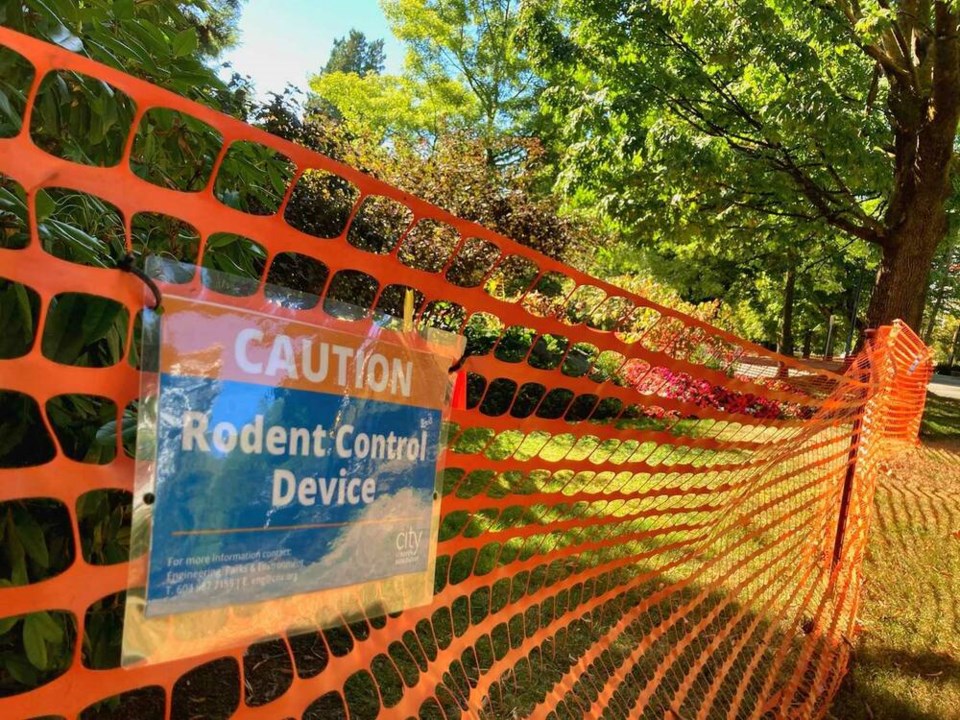For some living in the city, North Van feels like New York these days. It’s not for a reason you might think.
A population of rats has settled into Victoria Park, according to multiple reports and shrieks from people in the area. The rodents have been described as large (the size of “fat squirrels”), sometimes travelling in packs, coming out mostly at dusk, and living in concentrated numbers on the west side of the park.
The City of North Vancouver is aware of the issue, and has put up temporary orange fencing in areas where traps have been set. The municipality has hired a contractor to handle rodent control in the park and has introduced other measures such as signage to deter people from feeding wild animals, a spokesperson said.
On his daily after-work walk with his dog, nearby resident Ryan Scholz says he sees several rats every time he goes out. He’s also gotten in the habit of jingling his keys as he walks to avoid being spooked.
“I’ve seen groups of four to five rush out from underneath trees,” Scholz said. “It’s not dark outside, but they rush from underneath trees to go scavenge leftovers that people have left by the garbage cans or whatever. And the park is still pretty busy.”
“On one or two occasions I was like, ‘Oh my God, these rats don’t care about humans at all,’” he said.
Scholz lives in a building a block away from Victoria Park, and is also the co-founder of Shaketown Brewing Co. He’s lived in the area for around five years, and started noticing a surge in the number of rats around a month ago.
Municipal spokesperson Jody Robertson said the city investigated the issue and moved forward with mitigation strategies “as soon as this was brought to our attention.”
“Rats are a common part of North Shore wildlife and are best managed by reducing attractants such as potential shelter and food,” she said. “As with other human-wildlife conflicts, prevention is the preferred initial approach.”
To address the rat problem in the park, the city has removed open garbage bins and vegetation that could provide possible shelter, Robertson said.
City staff have also been communicating with park visitors to not feed the wildlife, as that can create food sources for rodents.
“We have found both bread and water set out by well-meaning people concerned about birds,” Robertson said. “We have connected directly with them and they have been very understanding and accommodating about not doing this anymore.”
To curb the number of rats directly, a city-hired contractor has put up out snap traps in secure boxes and is checking them every two days, Robertson said.
“We do not use bait traps because they can harm other wildlife such as owls, eagles, hawks, raccoons, and even cats and dogs who could consume the bait or the poisoned rodents,” she added.
Rodent populations ramped up during the pandemic, experts say
In recent years, so-called second-generation anticoagulant rodenticides have been banned across all North Shore municipalities. Use of these rodenticides has been widely restricted at the provincial level, with some exceptions for “essential services” like food producers and hospitals.
These bans have contributed to a growth in rodent populations, said Julie Scott, co-owner of Pestcheck Pest Control. While there are select allowable use cases, her business doesn’t use second-generation rodenticides at all, she added.
Rats also benefited from pandemic-related closures of restaurants, Scott said, which are a large part of urban pest control. Restaurants are also a source of food for rats, many of which went looking elsewhere during that time.
“During COVID they all went to the suburbs,” she said. “Since last year, we’ve been getting a lot more rodent calls.”
While the city didn’t provide an estimate for just how many rats now call Victoria Park home, Scholz guesses the number is at least a hundred, if not hundreds.
But there’s been some noticeable impact since the municipality has stepped in, he said. “I’m glad that that the city’s doing something about it.”
Given the potential for rats to carry disease, Scholz said he’s moderately worried about them scurrying about in the neighbourhood.
“If I had a first floor unit, like a garden entrance, I would definitely [take] a lot more precautions,” he said.



